PDF files has not been created for this issue.
Graffiti Art as Alternative Media During Covid-19 Pandemic
Abstract
The times of COVID-19 pandemic that the world is currently facing is a tremulous time indeed. Governments across the world are trying their best to cope with this situation. One of the most effective ways that is helpful to keep this condition in a sort of control has been creating awareness among the public so that they follow the rules and regulations put across by the government to safeguard the public’s health. Media has been playing a tremendous role in spreading awareness among the public about the outcomes of this situation that we are facing. In a country like India, where the population spans to approximately 1.3 billion with a literacy rate of 74.04% various forms of media are used to disseminate information. With the latest pandemic that shows no discrimination between caste, creed, color, social class or economic class, informing virus’s capacity to wreak havoc is of vital importance. Therefore propagation of awareness takes many shapes and forms. And one very intriguing phenomenon is the pop ups of various graffiti across the world and in India as well. This paper shall seek to examine the art of graffiti, its aesthetic qualities and its impact as an alternative media.
Keywords: Graffiti , Art, COVID-19, communication, Media, street art, aesthetics
Mainstream media and Alternative media
The term media, which is the plural of medium, is popularly referred to the communication channels through which we disseminate news, music, movies, education, promotional messages and other data. And with technological advancements it includes not just physical newspapers but also online newspaper apps and various other apps which are considered as New Media. The other types of media include Traditional Media which comprises magazines, television, radio, billboards, telephone, the Internet, fax and billboards. Folk Media which is more popular among the rural or countryside comprises communication mediums that are more artistic in nature and aesthetic in quality such as theatre, music, shadow puppetry, painting etc. When it comes to preservation some media are transient in nature such as theatre or music that is passed on from generation to generation to keep it as a sustainable dynamic form of media. Whereas some are permanent in nature such as newspapers that are archived, many printed books, and especially digital media with the virtual data storage systems.
Aforementioned Traditional media and New media(social media) are popularly known as Mainstream media. This type of media is known to have the power to influence larger numbers of people and often represent generally accepted beliefs and opinions. This type of media is oftentimes aligned with the government and is considered as a credible source of information. Alternative media on the other hand is known to use polarized methodologies for dissemination of information compared to mainstream media. It is often used by individuals or smaller groups and communities and aims at minority, or community groups about particular issues. The common forms used include graffiti, street theatre, pamphlets, and community newsletters etc. Since these are not corporately owned they are often used to circulate information that is under-represented by mainstream media.
Visual Art as a medium for communication
Visual arts as the name suggests is that form of art that meets the eye. It requires a certain level of technical skills, observation and imagination. Ancient forms such as drawing and painting are at the forefront when one describes visual arts. However, the evolution of our civilization at social, economic, cultural, spiritual and technological level has brought about drastic changes in how we consume visual arts. The role of technological advancements such as sculpture, printmaking, photography, and installation art to name a few has brought about very apparent, superficial yet ontological changes to how art is produced and consumed in today’s 21st century (Codreanu, 2015). It is known to have the power to evoke certain emotions within us humans on an epistemic level (BOLT, 2004). Visual art’s principal function involves evoking emotion through an expression of skill and imagination which essentially is a tool to communicate. Thus communication becomes the primary intention of any kind of image creation. And the purpose often stands with relying on visual representation rather than words. According to John Dewey Art is the “most universal and freest form of communication”. While Jürgen Habermas defines narrative art as “illocutionary disempowered,” since the “internal relation between the meaning and the validity of what is said survives intact only for the characters in the novel . . . but not for the real readers”. However, the idea here is to veer the discussion towards understanding the potential of visual art and its narrative element. An attempt to grasp the use of rudimentary style of graffiti art being used in this otherwise “digitally acclaimed” 21st century, during a pandemic which is in the process of being carved into the pages of history.
Graffiti as an Art form.
The origin of the word graffiti can be traced to the Italian word ‘Graffito’ meaning to scratch. Graffiti as an art form has a long and strong history of its own. Often this kind of art form is found outdoors on streets, walls, on buildings, unconventional platforms and public spaces that are exposed. Graffiti art can be created using materials such as spray paint, marker pens, stencils, acrylics to name a few. Graffiti art can be in both two dimensional and three dimensional formats. It uses various techniques to bring forth the drama that can only be achieved by a pictorial representation.
Delving into its history one can even relate and trace the ancestral style of “scratching” or doodling all the way back to the cave painting. For example the Chauvet caves in France or the Australian Aborginal rock art where artworks were predominantly done on the walls of the cave and also used techniques of spray painting with hollow bones, daubing, mixing, painting with brushes made out of hair and moss and spreading with fingers etc. Pigments to create paint were naturally sourced from minerals and earth. To an extent this rudimentary style of painting is still practiced among modern graffiti artists with few technological advancements in terms of paint materials and other kinds of tools. It has been suggested by scholars that these paintings could have served for ritualistic, or for educational purposes. The cave paintings offer a glimpse of innocent, almost unadulterated versions of intellect (not to be mistaken for naivety because the complexity of narrative is still under debate among scholars). This further reveals the intention that is offered in such kind of art forms the “freedom of communication”. These art forms comprise a pictorial narrative that ultimately has a quality of higher accessibility when compared to that offered by words (Dalibar, 2015). In its natural capacity, cave art exhibits instinctive creativity and freedom of communication that is embedded with intelligence that can be recognized as the foundation in all artistic endeavor.
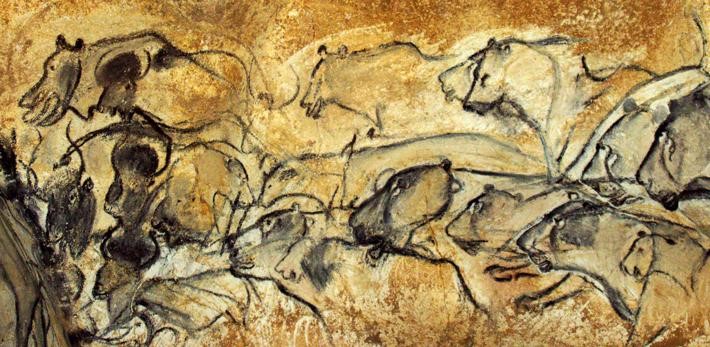
Figure 1: Lions, (Smithsonian Magazine, 2017) Chauvet Caves, France

Figure 2: Aborginal rock art, Nourlangie Kakadu National Park
Even the style of “form” found in the images of cave paintings also have similar characteristics of raw/rough (doodling and scribbling) portrayal of images often seen in pop/contemporary graffiti artists. Studies also suggest that graffiti can even be traced to the ancient Greek roman and Mayan sites where inscriptions have been found on the walls (Singh, 2018).
Art with an Agenda ( International ).
Graffiti art’s marriage with American pop culture began during the 1960’s as it was with this shift in culture that had brought about more prominence to this otherwise considered “rebel” art form. Darryl McCray or Cornbread, Cool Earl, Top Cat 126, Demetrius aka Taki 183, Tracy 168 to name a few started to become popular tags found around the city of New York. These graffiti artists were known all too well for their counter-culture visual narratives and methodologies, however commonly acknowledged as “vandalism”. These Graffiti artists’ origins often can be traced from prisons, lower income social class with difficult social lives and poverty. Graffiti was the approach to bring themselves and their community to the forefront with the help of alternative media, since mainstream media was out of reach and only accessible by certain niche communities. These artists however became merciless in their approach as they would not spare even the lamp posts, street signs, buildings, and especially subway cars. The 60’s and 70’s became the golden era for pop culture and art. As graffiti started gaining reputation, it began shifting from streets to art galleries, films and paradoxically into mainstream media outlets. Jean-Michel Basquiat was a street artist turned popular graffiti painter. Basquiat’s works often communicated his unhinged racial reality as an African-American living in a dominant “white” culture. Thus his works were often politically and socially charged with emotions of fear and uncertainty. His artworks were highly symbolic in nature which was evident in his bold and haunting use of forms, flat yet and loud use of colors, aggressive brush strokes and text(that was also a part of the visual narrative). In the panel painting titled ‘Flexible’, is a painting done in the “graffiti”style examining identity. The painting is known for its most arresting and iconic black distorted figure.

Figure 3: Flexible by Jean-Micheal Basquiat
Today artists such as Banksy, Cornbread, and Taki 183 are still active in their fields. And often use graffiti as a means of alternative propaganda tool. Banksy is an extremely popular, anonymous British graffiti artist and activist whose popularity is also tied with his mysterious persona (often used to evade authorities as he states) tied with his artwork, since graffiti still wears the shroud of vandalism, rebellion, disrespect towards authorities. However, his works are known for bringing to light political messages, which otherwise are recessively experienced in society but exist nevertheless. With his use of stencil, he cuts short his time to create his works and that results in mysterious overnight pop ups of graffiti work on walls of England almost always carrying a message for the onlookers. (Guy Hepner) (Mancoff)
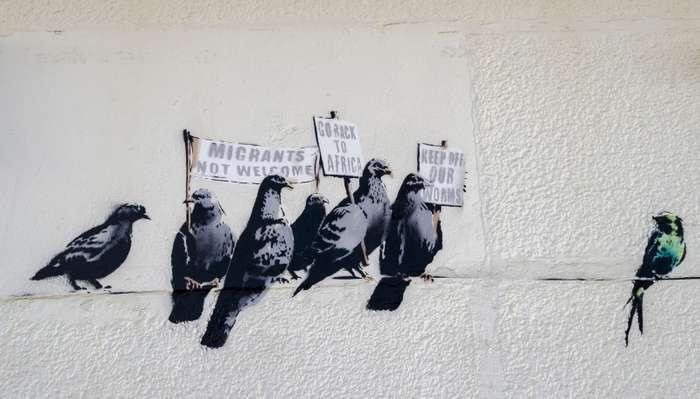
Figure 4: Banksy: Clacton-on-Sea mural
Mural by Banksy at Clacton-on-Sea, Essex, England, 2014. It was removed by the council following complain that it was racist.
Art with an Agenda (India).With the “freedom of communication” that comes graffiti style artwork has blazed all across the globe. This form of communication does not require any schooling in Fine Arts. In India graffiti inscriptions can be found on school benches, to public bathroom stalls, old abandoned buildings, government hospitals, Indian railway coaches, bus depots and public walls etc. This form of art allows it to flourish in any kind of media. At the same time serving as an alternative mass media that does not always cost to look at. Its unique quality also includes becoming part of the city/urban landscape adding to the history and story to a city. India is known for its vibrant visual culture and history and if one were to look closely Graffiti and street art already existed within the fabric of ceremonial and religious sentiments. For example Kolam which is a traditional, ceremonial art form from south of India, is drawn on the street by women practicing Hindu religion. Warli is yet another “graffiti” style artwork painted on various mediums, which originally is part of traditional folk media from Maharashtra. Warli is used as a mode to pass on traditions from one generation to the other. Especially for the ones lacking literacy. Therefore visual literacy of such kind serves the universal purpose. The aesthetic values of these types of traditional artwork has seeped into the contemporary graffiti/street artwork styles. In India graffiti is illegal and nevertheless are not so much opposed to the idea. Therefore, many times it is sanctioned for various purposes by companies, groups or communities and by the government itself. The purpose may vary from advertising, political agendas, community messages, or simply for decorative purposes.
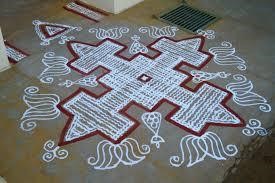
Figure5: kolam from south India (anonymous artist)
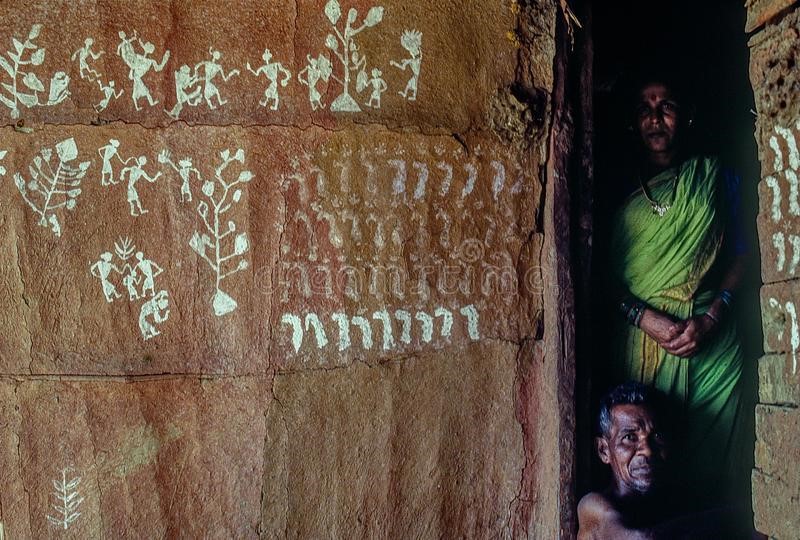
Figure 6: Traditional warli painting on wall (Dhanu district ,Thane)
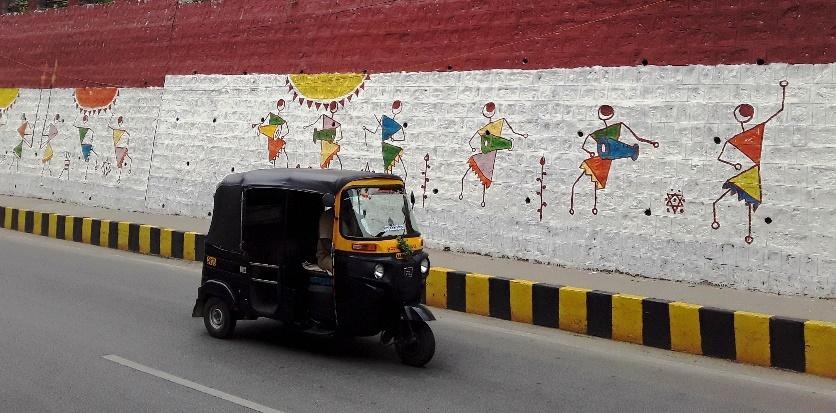
Figure7: Contemporary warli painting on public wall (mysore)
Graffiti’s’ known for its popular trait of being associated with underground culture, however, it is now finding its way to the as a vivacious street art movement. Numerous street artists, art communities and foundations are transforming urban landscapes across India with paints, stencils and spray cans. Latest graffiti scene in India has propelled forward with various schemas. Artists such as Yantr, Zake, Jheel Goradia, Jas Charanjiva , Anpu varkey and many others work individually and keep persuading Indian society through messages within their piece of art which is mostly bringing to limelight conditions endured by the people , such as socio-economic clashes among different communities and classes, political turmoils, Gender disparities, sexual violence etc.
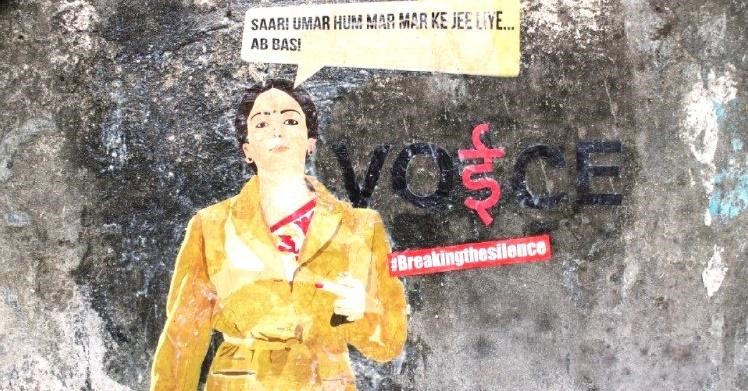
Figure 8: Jheel Goradia #breakingsilence

Figure 9: Jas Jas Charanjiva ‘Pink Lady’
Artist Aastha Chauhan in 2012 had organized a street art festival “ Extention Khirke” in Khirki Village situated in Delhi. It was backed by FICA a not-for-profit Foundation for Indian Contemporary Art which provided a platform to graffiti writers from all across the country and world to share their talent and ideas. With Khirke being the Petri dish of various middle class, lower middle class and migrant communities it provided a great playground for artists to experiment with the ideological and physical space (Chauhan, 2018). Foundations such as St+Art India work on various collaborations with artists from India and around the world and other collective art groups and focus on bringing art to the Indian public. The intention is to take ‘art’ out of galleries, museums other conventional spaces and create a more experiential and site specific outcome that can be enjoyed and disseminated for all socio-economic classes. Aravani Art project is women and transgender art collective. These group of artists focus on public/street art to shed light on violence, harassment in public, social unacceptance etc faced by women and Transgenders in public.

Figure 10: Mahatma Gandhi at Churchgate railway station by St+art and Eduardo

Figure 11: Dharavi Project Mumbai(Aravani Art project)

Figure 12: KR market, Bengaluru
Role of Art during Pandemic
Our world has endured some grave pandemic in its wake, various kinds of plague, Spanish Influenza, to AIDS, H1N1 and many other Epidemics. The Spanish flu pandemic, one of the most devastating diseases, has some unnerving similar qualities to that of COVID-19. The Spanish flu pandemic had taken over 17 million lives around the world. Currently with the repercussions of COVID-19 people are glued to their screens as means of keeping up with the news and for other updates related to this disease. Especially since social distancing is a key factor in preventing its person-to-person transmission and global impact. Media has been a crucial entity in documenting our realities. And visual documentation especially plays a tremendous role, because “seeing come before words” as mentioned by famous British art critic John Berger. Therefore, visual grammar is an inevitable part of our lives with universal qualities of comprehension of emotions, forms, shapes, colors and several other aesthetic attributes. Known artists from the past such as Edvard Munch, Pablo Picasso, Keith Haring among many others from the past have delved into framing sufferings of many kinds on to various types of canvases.
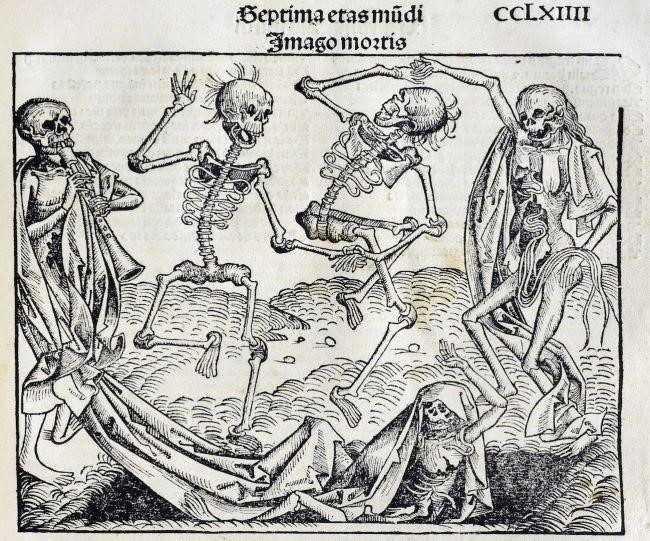
Figure 13: Illustration from Liber chronicarum, 1. CCLXIII; Skeletons are rising from the dead for the dance of death

Figure 14: Edvard Munch, Self-Portrait with the Spanish Flu (1919).
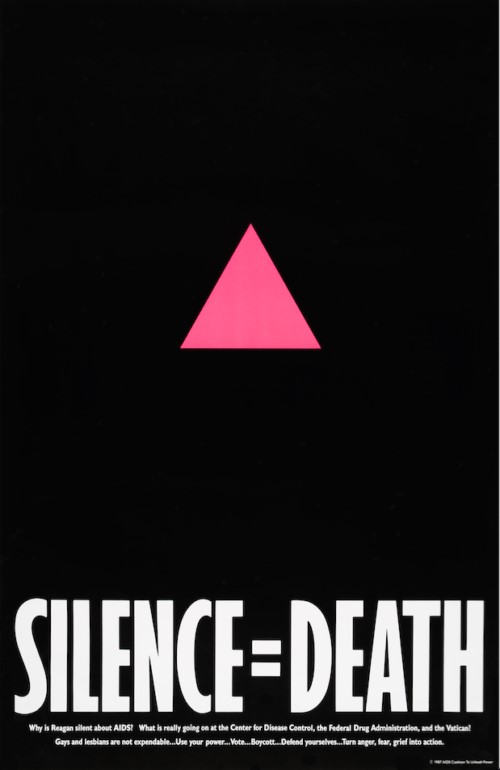
Figure 15: A pink triangle against a black backdrop with the words 'Silence = Death' 1987, colour lithograph by ACT UP (collective)
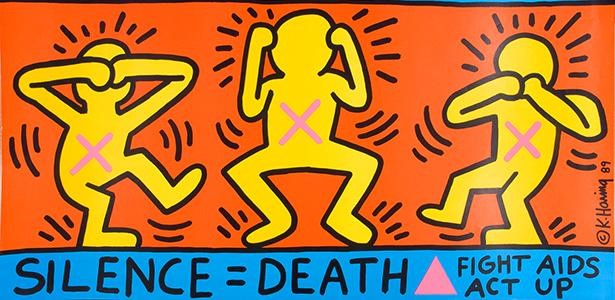
Figure 16: Keith Harring on AIDS
Graffiti and COVID-19 pandemic.
COVID-19 stands for Coronavirus disease and 19 stands for the year it began (Dec 2019, originating in Wuhan,China). This disease rapidly spread around the world and started claiming lives, discriminating against none. Race, caste, creed, social status, economic status none of it matters to this virus. The world opened its eyes to the repercussions of COVID-19 Pandemic around February/March of 2020. Soon the world had to go into massive reclusion on several levels. First and foremost duty of all governments and many health administrations was to raise awareness about the disease and the pandemic that it has caused. Mainstream media, Digital/New media has been covering news, creating awareness and constantly feeding updates to all, around the world 24/7.
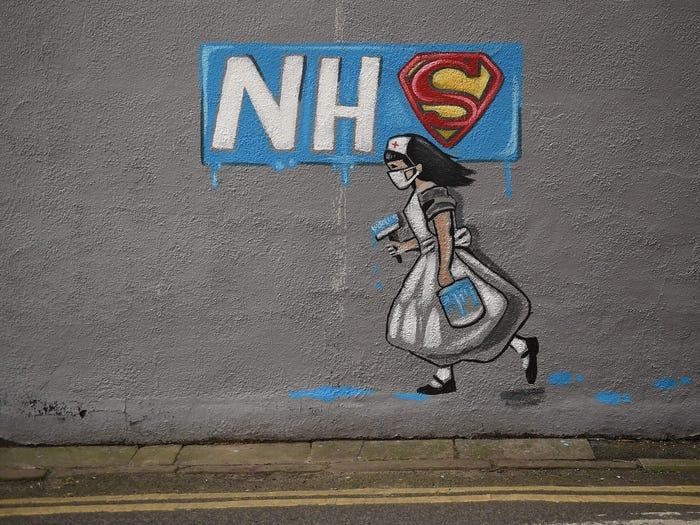
Figure 17: Street art in England

Figure 18: West coast street artist Hijack Art has created a mural of two soldiers fending off the coronavirus in the Pico-Robertson neighborhood of LA.
During the Coronavirus Pandemic the health services across the world, military and other official authorities have been on the frontline fighting against the pandemic. Keeping order amidst the havoc wreaked by this deadly virus has been very crucial and therefore their roles and duties of individuals in the above mentioned line of work are working without any breaks. Figure 17 graffiti found in England represents the NHS (National Health Service,UK) as the superhero with the ‘S’ being replaced with the iconic logo of ‘Superman’ from DC comics, who is known to save people in danger. The woman wearing a nurse's uniform with a paint brush is represented in the caricature format often found in comics. The contrast use of colors such as red, blue, gray, white and black highlights the ‘S’ in NHS and the Nurse. Figure 18, According to the artist “This particular issue involving the coronavirus and all the devastation it’s leaving in its wake, was a no-brainer for me,”.The fear and call to action of this pandemic has really captured the imagination of many in and outside my city.” The stencil type Banksy inspired art is large and life size. Colors contrasts highlighting the sanitizer, duster, toilet paper (which the west started hoarding), and the vacuum cleaner like machine. These cleaning products have replaced the guns and other artillery which otherwise is carried by the army personnel.
COVID-19 Graffiti in India. In India around 600 million of the population has access to the internet and many still access to traditional media. However, there is still a huge population below the poverty line, lower economic income who are unable to access any kind of media. And during this pandemic access to information to all is extremely vital. Therefore, alternative media such as Graffiti serves the purpose of educating the common public. Many such artworks by anonymous artists and known artists along with the authorities took to streets and public walls to propagate the effects of this virus. Many such graffiti artworks started popping up around the country. The pictorial representation included from creating awareness of how to take precaution, to enlarged representations of the virus itself and the ramifications one could face if one doesn’t abide by the regulations passed on by the health administrations and government.
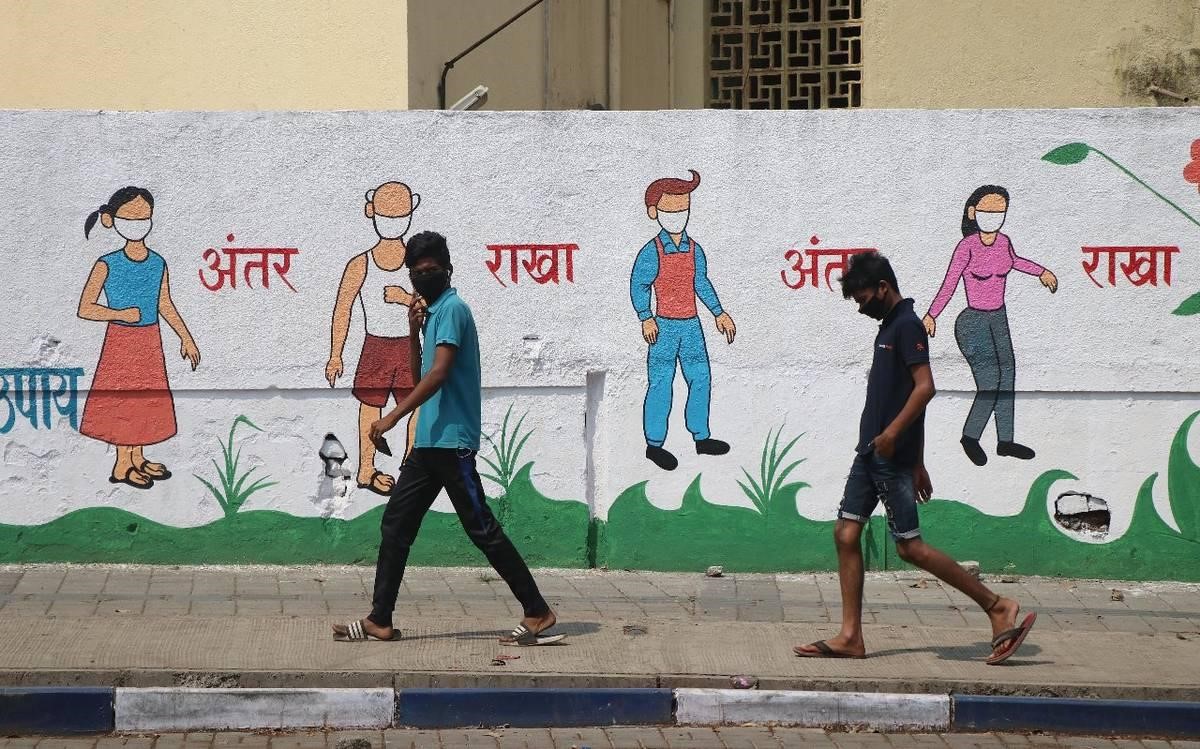
Figure 19: Pedestrians crossing a wall painting on the importance of social distancing at Dahanukar colony, Pune
In figure 19, the message communicates to maintain social distancing on a public wall. The painting uses contrasting colors of red, blue, pink gray, etc against a white wall. The colors have been applied which gives it a flat appearance lacking any depth to the image itself. The image features a girl, an old man, a young man, and women dressed differently. The young man and women seem to belong to what appears to be upper, middle socio-economic class because of the clothing they don, and the old man and the girl seems to belong from the lower socio-economic class. The simple idea here is that maintaining social distance is applicable to all and the virus does discriminate based on age. Aimed correctly, the photograph also contains two young men who appear to belong from middle socio-economic class walking past the painting. Apart from the forms painted the painting also contains texts written in Hindi stating to “maintain distance” which is also incorporated in a creative manner in between each figure suggesting the same. Often such kinds of images are predominantly seen on children’s educational or story books. It's simple to look at, comprehensive, and serves the purpose of keeping the city walls clean and decorative.

Figure 20: Coronaviruses are a group of viruses that have a halo or crown-like (corona) appearance when viewed under a microscope
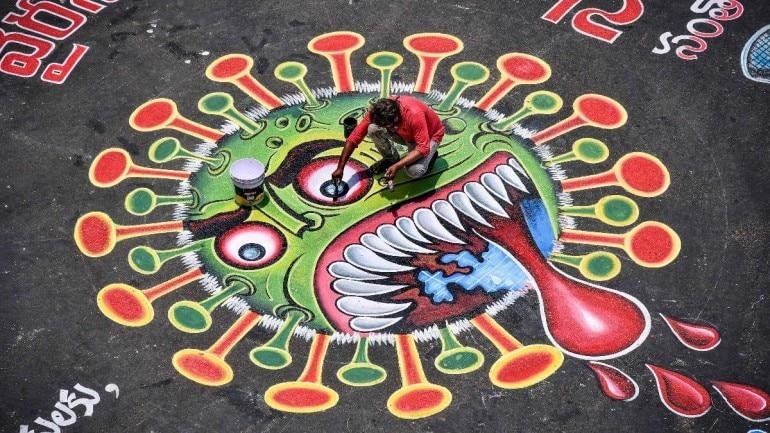
Figure 21: Street graffiti painted in Vijayawada to raise awareness about Covid-19.
In figure 20, one can notice the obvious exaggerated caricature of the coronavirus. Several such caricatures were painted across the country. The virus has a spike like protein sticking out of its body, which is similar to a crown thus it got christened as Coronavirus. The popular spike image of the virus got its reference from the photographs the labs circulated. These images are from under the microscope (figure 21). The virus which is otherwise invisible to the naked eye got ‘larger than life’ portraits of it drawn across the world with graffiti/street style. Taking reference from these photographs many artists have dedicated enormous artworks. The sheer size given to these artworks can be related to the massive impact it has brought about on the world. This virus has so far claimed about 2 million lives around the world and is still counting. It has brought all our lives to a grinding halt. The various other crises that it has brought about in each and every individual's lives has been highly detrimental in showcasing (in the artworks) the virus in all its evil glory. The highly contrasting and bold colors, personification with bloody eyes, fangs, blood dripping, thick eyebrows, color scheme and large spikes portrays the virus like a devious monster. The overly dramatic expression given to the virus represents the highly malicious quality of the virus.

Figure 22: Buddha graffiti in Mumbai

Figure 23: Coronavirus graffiti by Indian police in Bangalore, India, April 3, 2020
In figure 20, the Banksy Style, Stenciled Budha graffiti can be seen. Budha is known as an icon for peace worldwide. At a time where the world is in shock and has started panic buying, suffering from anxiety and other mental ailments thinking about the future, this image of Buddha notifies its viewers to keep calm (Brewer, 2020). The subtlety in form of the body drawn, the hand gestures and the rested sitting position is all pointing towards keeping a leveled head approach towards dealing with the crisis. In this particular artwork the Buddha is also wearing a mask, directly relating it to the current condition where wearing a mask is highly recommended and many countries have also made it mandatory to wear masks in public. This makes the artwork very relevant to what is being asked of the public. At the same time using Banksy’s style of stencil, contrasting colors and technique makes this artwork contemporary as well. Once again, a large and life size image makes it more relatable and visible to all. Figure 21 showcases, paradoxically the Indian police participating in an awareness campaign by drawing large graffiti of coronavirus at all traffic junctions. Usage of texts and hashtags (popularly used in social media to engage and circulate using tags to wider population) in the graffiti making it more appealing as an image as well as imbibing the digital hashtag culture (Berg, 2014). The motive behind all the graffiti during this time served the purpose of urging people to cooperate with the Indian government-imposed nationwide lockdown as a preventive measure against the COVID-19.
Conclusion
Due to the lockdown currently implemented across the country (India) that prohibits from loitering in public places all the images above were sourced from the internet. Ironically from websites of mainstream media while the discussion being held here is on alternative media.
- This goes to show the significance of the marriage between many types of media. Social media, photography and hand painted artwork etc to name a few are extremely vital during times like this where humanity needs to operate as one unit. The amalgamation of all media can further propel the reach of information. And visual representations are capable of reaching all types of people across the world and are universal with its messages. Unlike language and words, visual grammar is capable of achieving a universal language,that can cross all borders and races etc. However, the discussion already exists in regards to extensive consumption of images via New media(social media). And enduring a pandemic during the 21st century digital era has become all the more about consuming, especially consumption of images in a grid format with our mobile devices being the primary medium of delivery amongst other electronic devices. The amount of screen time during a crisis like this needs further reviewing.
- In regards to graffiti/street art itself, loud, bold and bright colors seem to be the noteworthy trait of graffiti as an art form. The figures and form hold prominence, as often when it comes to any kind of street/graffiti art there is an expectation of a certain level of skill, as the surface is often unconventional, unlike paper or canvas. Size of the artwork is yet another extremely important aspect, since street art is often intertwined within the urban landscape the possibilities of it not being noticed are high especially with high rise buildings. Therefore, graffiti artworks are often extremely large and occupy a large physical space and most importantly aim to occupy ideological space.
- The amalgamation between aesthetics of the artwork and Media seems to be the necessity of the hour. By arresting the viewers’ attention is the only way to propagate the concept behind the graffiti and hoping for the best that the message is driven home.
- Communication is a key factor in almost all street graffiti. The artwork is often simple in its representation, since the audience can be of various backgrounds. Key to successful communication lies with clarity in message. Therefore, Democratization of visual narrative could possess the answer to bringing unity amongst humanity.
Works Cited
- (n.d.). Retrieved from University of Cliforia Press: https://www.ucpress.edu/blog/27892/the-artist-behind-the-iconic-silence-death-image/
- (n.d.). Retrieved from Guy Hepner: https://guyhepner.com/product/flexible-by-basquiat/
- (n.d.). Retrieved from Kolam: https://en.wikipedia.org/wiki/Kolam
- (2017). Retrieved from Start India: https://st-artindia.org/
- (2017, April 7). Retrieved from Smithsonian Magazine: https://www.smithsonianmag.com/sponsored/australia-northern-territory-ancient-aboriginal-rock-art-sites-cultural-outdoor-travel-180962576/
- Arora, A. (2020, April 20). India today webdesk. Retrieved from India today: https://www.indiatoday.in/science/story/indiatoday-econclave-corona-series-virologist-biotech-investor-peter-kolchinsky-covid19-1669045-2020-04-20
- Art and Design. (2020). Retrieved from The Guardian: https://www.theguardian.com/artanddesign/2020/mar/25/street-artists-coronavirus-us-it-feels-like-wartime
- Berg, J. A. (2014). The story of the hashtag(#): A practical theological. researchgate , 6.
- Berger, J. (1972). Ways of seeing. Pengiun.
- BOLT, B. (2004). ART BEYOND REPRESENTATION. I.B.Tauris & Co Ltd.
- Brewer, K. (2020, March 16). Coronavirus: How to protect your mental health. Retrieved from BBC: https://www.bbc.com/news/health-51873799
- Brocklehurst, S. (2020, April 15). The woman who discovered the first coronavirus. Retrieved from BBC: https://www.bbc.com/news/uk-scotland-52278716
- Charanjiva, J. (2016, July 2). Retrieved from tumblr: https://jascharanjiva.tumblr.com/post/146812351618/the-pink-lady-aka-dont-mess-with-me-pasted-in
- Chauhan, B. (2018). THE IMPACT OF SOCIAL-CULTURE ON THE ACCEPTANCE OF GRAFFITI . Impact Journal, 16.
- Codreanu, F. (2015). ART AND TECHNOLOGY – THE ROLE OF TECHNOLOGICAL ADVANCE IN ART HISTORY. Retrieved from ResearchGate: https://www.researchgate.net/publication/277309359_Art_and_Technology_-_The_Role_of_Technological_Advance_in_Art_History/link/5566f2ba08aeccd77735e80d/download
- Collins Dictionary. (2020, April). Retrieved from https://www.collinsdictionary.com/dictionary/english/mainstream-media
- Dalibar, C. (2015). Truest Art of Them All: From Paleolithic Cave Paintings to Graffiti. Research gate, 19.
- Das, S. C. (n.d.). Relevance of Graffiti Art as an Art Form in Indian Context. Retrieved from Shodhganga: https://shodhganga.inflibnet.ac.in/bitstream/10603/97079/5/th-1806_ch3.pdf
- Dave, A. (2016, February 19). Warli Painting on the wall of warli House Dahnu district Thane. Retrieved from Dearmstime: https://www.dreamstime.com/photos-images/warli-painting.html
- Dewey, J. (1934). Art as experience. Minton, Balch & Company.
- Ellsworth-Jones, W. (2013, February). The Story Behind Banksy. Retrieved from Simthsonian Magazine: https://www.smithsonianmag.com/arts-culture/the-story-behind-banksy-4310304/
- Engineer, R. (2018, July 12). 5 Brilliant Female Artists Taking Over India’s Street Art Scene! Retrieved from The better India: https://www.thebetterindia.com/150239/female-artists-india-street-graffiti-news/
- Fickling, D. (2006, February 26). Cave paintings are graffiti by prehistoric yobs. Retrieved from Independent : https://www.independent.co.uk/news/science/cave-paintings-are-graffiti-by-prehistoric-yobs-6108231.html
- GARBER, M. (2008, October). Confirmed: The Oldest Known Art in the World Is Spray-Painted Graffiti. Retrieved from The Atlantic: https://www.theatlantic.com/author/megan-garber/
- Gill, M. S. (2016, May 7). Writing’s on the wall, so is apathy. Retrieved from The tribune: https://www.tribuneindia.com/news/archive/features/writing%E2%80%99s-on-the-wall-so-is-apathy-233609
- Jahn, G. R. (1975). The Aesthetic Theory of Leo Tolstoy's What Is Art? JSTOR.
- Jarus, O. (2020, March). All about History. Retrieved from https://www.livescience.com/worst-epidemics-and-pandemics-in-history.html
- Kapoor, R. (n.d.). Visual word of Warli. Retrieved from http://www.dsource.in/ourdsource/sites/default/files/e_book.pdf
- Karthik Shetty, A. J. (2016, June). Dharavi Mumbai. Retrieved from Aravani art project: https://aravaniartproject.com/dharavi-mumbai_03
- Karthik Shetty, S. M. (2016, January). Retrieved from Aravani Art project: https://aravaniartproject.com/kr-markert_01
- LaMarco, N. (2018, october 12). Mainstream Vs. Alternative Media. Retrieved from Chron: https://smallbusiness.chron.com/mainstream-vs-alternative-media-21113.html
- Last Name, F. M. (Year). Article Title. Journal Title, Pages From - To.
- Last Name, F. M. (Year). Book Title. City Name: Publisher Name.
- Mancoff, D. N. (n.d.). Retrieved from Britannica: https://www.britannica.com/biography/Banksy
- Marchant, J. (2016, January). SMITHSONIAN MAGAZINE. Retrieved from SMITHSONIAN MAGAZINE: https://www.smithsonianmag.com/history/journey-oldest-cave-paintings-world-180957685/
- Mistry, J. (2020, March 26). India coronavirus lockdown, day 2 updates. Retrieved from The Hindu: https://www.thehindu.com/news/national/india-coronavirus-lockdown-day-2-updates-march-26-2020/article31169318.ece
- O’Grady, M. (2020, April 8). The new yorktimes style magazine. Retrieved from Newyork times: https://www.nytimes.com/2020/04/08/t-magazine/art-coronavirus.html
- Olito, F. (2020, April 9). Lifestyle. Retrieved from Insider: https://www.insider.com/photos-coronavirus-street-art-around-the-world-2020-4
- RAJAGOPAL, D. (2020, March 17). Politics and Nation. Retrieved from The Economic Times: https://economictimes.indiatimes.com/news/politics-and-nation/coronavirus-outbreak-how-much-testing-should-we-do-and-where-are-we-on-developing-a-vaccine/articleshow/74666658.cms?from=mdr
- Seth, R. (2014, July 31). Warli folk paintings: an insistent expression. Retrieved from Shodhganga: https://shodhganga.inflibnet.ac.in/bitstream/10603/21896/10/10_chapter3.pdf
- Sharma, M. (2016, May 1). ‘Art for everyone’: Delhi turns into a canvas for street artists. Retrieved from hindustantimes: https://www.hindustantimes.com/delhi/art-for-everyone-delhi-turns-into-a-canvas-for-street-artists/story-XYvFH7GTQNlxYJkpUDnIEM.html
- Sherwin, S. (2019, Aug 23). Retrieved from The guardian: https://www.theguardian.com/artanddesign/2019/aug/23/keith-haring-ignorance-equals-fear
- Singh, N. (2018). Graffiti: A new emerging art form in Indian streets. International Journal of Humanities and Social Science Research, 5.
- Visual Arts. (2020, April 25). Retrieved from ENCYCLOPÆDIA BRITANNICA: https://www.britannica.com/browse/Visual-Arts
- Wikipedia . (n.d.). Retrieved from https://en.wikipedia.org/wiki/Warli_painting
- Xinhua/Stringer. (2020, April 3). Xinhua net. Retrieved from http://www.xinhuanet.com/english/2020-04/05/c_138948642.htm
- ZORICH, Z. (2017, Aug). A publication of the Archaeological Institute of America. Retrieved from Archaeology: https://www.archaeology.org/issues/221-1607/trenches/4551-trenches-france-chauvet-dating